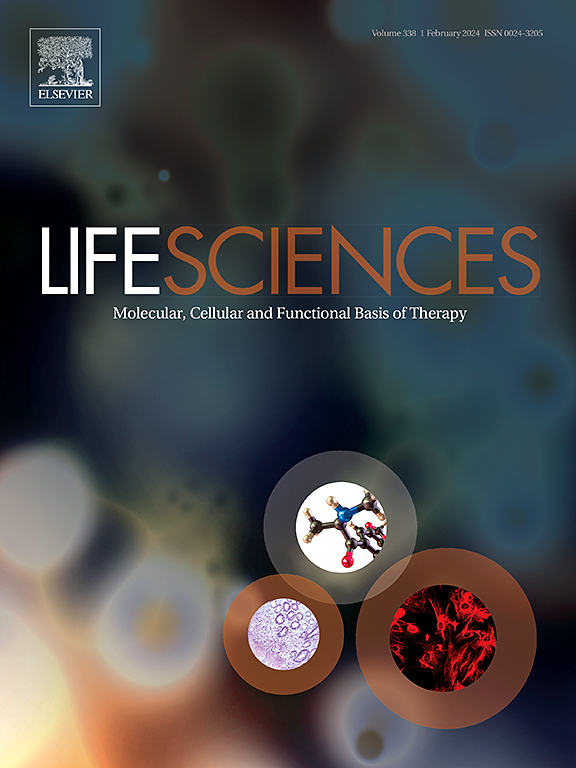Absence of Rab39b-induced macroautophagy impairment increases neurotoxic α-synuclein and causes degeneration of substantia nigra dopaminergic neurons in mouse model of X-linked Parkinson's disease
IF 5.1
2区 医学
Q1 MEDICINE, RESEARCH & EXPERIMENTAL
引用次数: 0
Abstract
Deletion or mutation of RAB39B gene causes RAB39B deficiency in male patients and resulting X-linked Parkinson's disease (PD). Male Rab39b knockout (Rab39b-/Y) mouse, which simulates PD RAB39B genetic mutation-induced absence of functional RAB39B, was prepared to study pathomechanisms of RAB39B deficiency-evoked neurodegeneration of substantia nigra (SN) dopaminergic cells. Rab39b-/Y mice manifested PD motor impairment, degeneration of SN dopaminergic neurons and presence of SN Lewy bodies. Rab39b insufficiency caused macroautophagy impairment via reducing Atg3, Atg5, Atg7, Atg12 and Atg16L1 in SN. Rab39b deficiency-induced macroautophagy impairment upregulated α-synuclein within SN dopaminergic neurons and α-synuclein oligomers in SN. Macroautophagy activator rapamycin reversed macroautophagy dysfunction or upregulation of SN α-synuclein and ameliorated motor deficits and demise of SN dopaminergic neurons in Rab39b-/Y mice. Rab39b paucity-promoted upregulation of ER α-synuclein activated ER stress-triggered apoptotic signaling in SN. Rab39b insufficiency increased SN mitochondrial α-synuclein and produced mitochondrial defect and oxidative stress. Rab39b deficiency-induced ER stress apoptotic signaling, mitochondrial impairment and oxidative damage activated mitochondrial pro-apoptotic pathway in SN. Rab39b deficiency-induced upregulation of α-synuclein oligomers induced excitation of SN microglia and NLRP3 inflammasome and elevation of IL-1β, IL-18 or TNF-α. Rab39b paucity-induced upregulation of pro-inflammatory cytokines activated MKK4-JNK -c-Jun/ATF-2 pro-apoptotic cascade and RIPK1-RIPK3-MLKL necroptotic pathway in SN. Our results suggest that RAB39B deficiency causes demise of SN dopaminergic neurons and X-linked PD by impairing macroautophagy and upregulating neurotoxic α-synuclein, which stimulates ER stress and mitochondrial apoptotic cascades and activates microglia and NLRP3 inflammasome. Our data also suggest that rapamycin possesses therapeutic effects on RAB39B mutation-induced X-linked PD.
在x连锁帕金森病小鼠模型中,rab39b诱导的巨噬损伤缺失增加了神经毒性α-突触核蛋白,导致黑质多巴胺能神经元变性
RAB39B基因缺失或突变导致男性患者RAB39B缺乏,从而导致x连锁帕金森病(PD)。制备Rab39b基因敲除(Rab39b-/Y)雄性小鼠,模拟PD Rab39b基因突变诱导的功能性Rab39b缺失,研究Rab39b基因缺失引起的黑质多巴胺能细胞神经退行性变的病理机制。Rab39b-/Y小鼠表现为PD运动障碍,SN多巴胺能神经元变性,SN路易小体存在。Rab39b不足通过降低SN中Atg3、Atg5、Atg7、Atg12和Atg16L1导致巨噬损伤。Rab39b缺陷诱导的巨噬损伤上调SN多巴胺能神经元α-突触核蛋白和SN α-突触核蛋白低聚物。巨噬激活剂雷帕霉素可逆转Rab39b-/Y小鼠巨噬功能障碍或SN α-突触核蛋白上调,改善SN多巴胺能神经元的运动缺陷和死亡。Rab39b缺乏促进内质网α-突触核蛋白激活内质网应激引发的SN细胞凋亡信号的上调。Rab39b不足导致SN线粒体α-突触核蛋白升高,产生线粒体缺陷和氧化应激。Rab39b缺陷诱导内质网应激凋亡信号,线粒体损伤和氧化损伤激活线粒体促凋亡通路。Rab39b缺陷诱导α-突触核蛋白寡聚物上调,诱导SN小胶质细胞和NLRP3炎性体兴奋,IL-1β、IL-18或TNF-α升高。Rab39b缺乏诱导的促炎细胞因子上调激活了SN中MKK4-JNK -c-Jun/ATF-2促凋亡级联和RIPK1-RIPK3-MLKL坏死坏死途径。我们的研究结果表明,RAB39B缺乏通过损害巨噬和上调神经毒性α-突触核蛋白导致SN多巴胺能神经元和x连锁PD的死亡,α-突触核蛋白刺激内质网应激和线粒体凋亡级联反应,激活小胶质细胞和NLRP3炎性体。我们的数据还表明,雷帕霉素对RAB39B突变诱导的x连锁PD具有治疗作用。
本文章由计算机程序翻译,如有差异,请以英文原文为准。
求助全文
约1分钟内获得全文
求助全文
来源期刊

Life sciences
医学-药学
CiteScore
12.20
自引率
1.60%
发文量
841
审稿时长
6 months
期刊介绍:
Life Sciences is an international journal publishing articles that emphasize the molecular, cellular, and functional basis of therapy. The journal emphasizes the understanding of mechanism that is relevant to all aspects of human disease and translation to patients. All articles are rigorously reviewed.
The Journal favors publication of full-length papers where modern scientific technologies are used to explain molecular, cellular and physiological mechanisms. Articles that merely report observations are rarely accepted. Recommendations from the Declaration of Helsinki or NIH guidelines for care and use of laboratory animals must be adhered to. Articles should be written at a level accessible to readers who are non-specialists in the topic of the article themselves, but who are interested in the research. The Journal welcomes reviews on topics of wide interest to investigators in the life sciences. We particularly encourage submission of brief, focused reviews containing high-quality artwork and require the use of mechanistic summary diagrams.
 求助内容:
求助内容: 应助结果提醒方式:
应助结果提醒方式:


